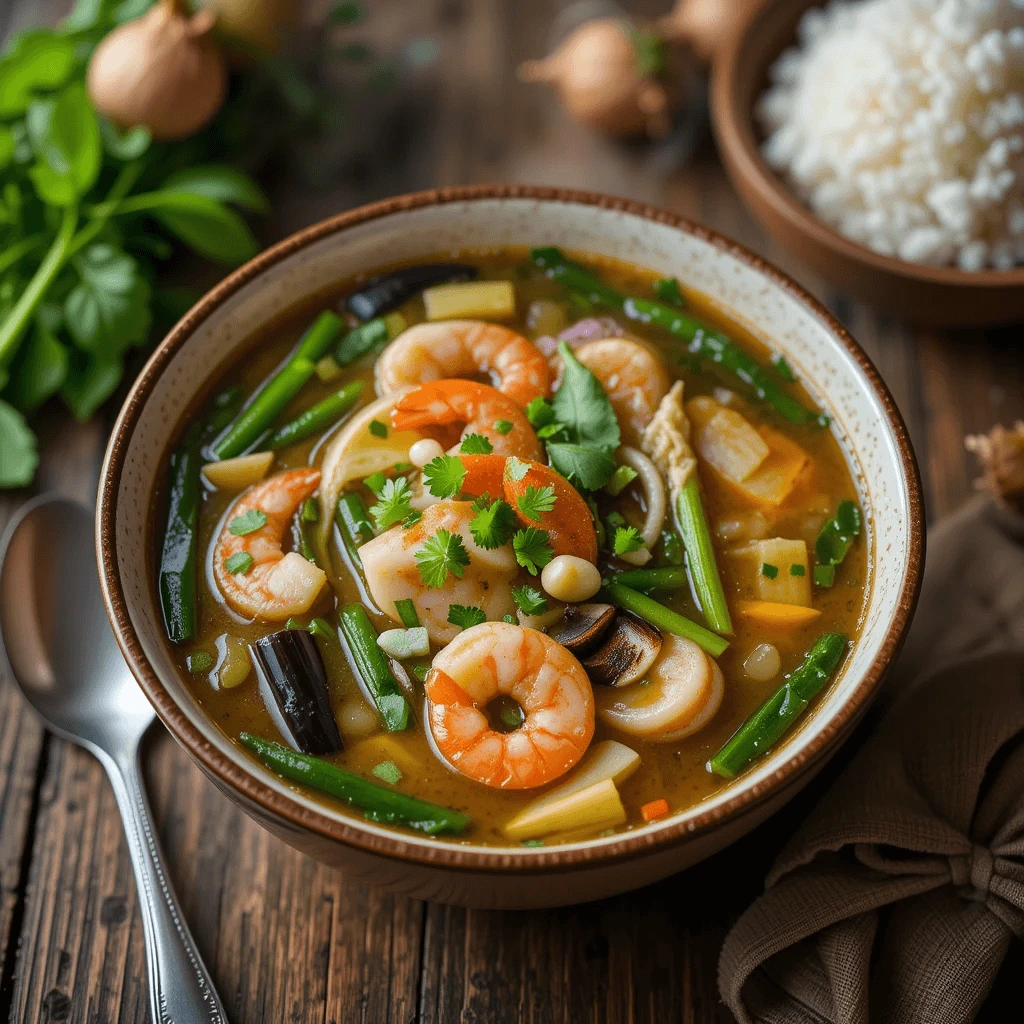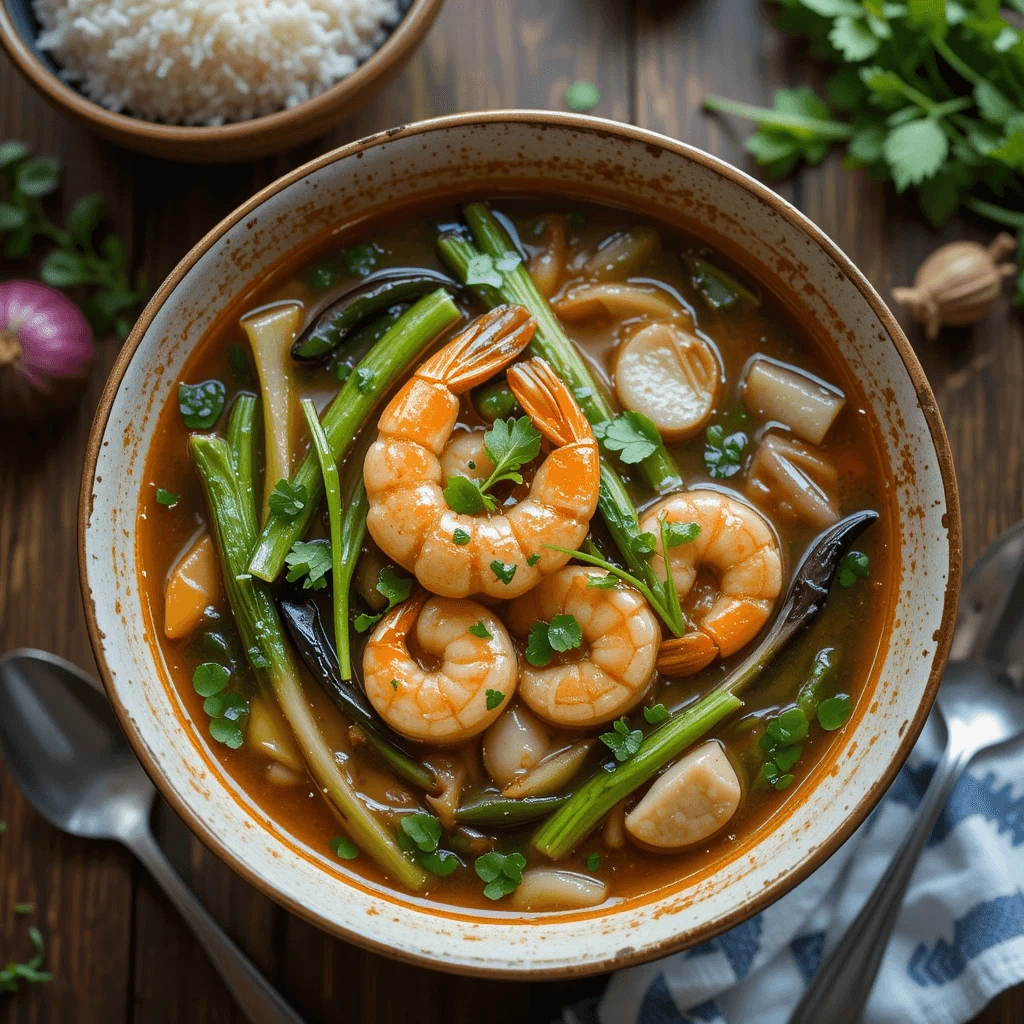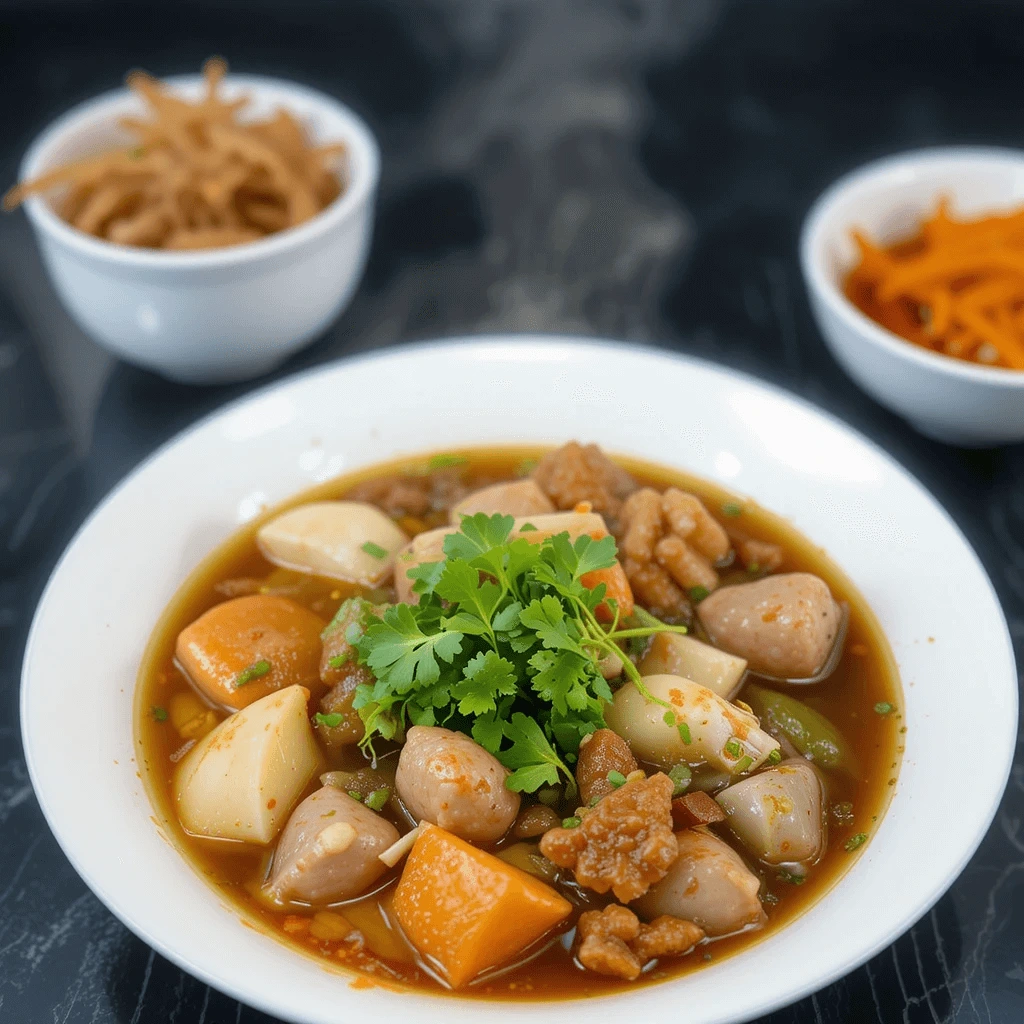Sinigang is a beloved Filipino dish that has captured the hearts of many with its perfect balance of sour, savory, and comforting flavors. This traditional Filipino sour soup is often made with tender meats such as shrimp (Sinigang na Hipon), or fish (Sinigang na Isda)…, combined with a variety of fresh vegetables. The signature tangy flavor comes from tamarind, which gives the soup its distinctive sourness, creating a satisfying and refreshing taste with every spoonful.
What makes Sinigang even more special is how easy it is to make from scratch, even for beginners. With just a few simple ingredients and basic cooking techniques, you can recreate this iconic Filipino dish in your own kitchen. Whether you’re a seasoned cook or a beginner, this Sinigang recipe for beginners offers an accessible and delicious way to experience the flavors of the Philippines, making it a must-try for anyone craving a homemade, heartwarming bowl of soup.
So, if you’re ready to enjoy a comforting, flavorful meal, this guide will show you how to make the perfect Sinigang from scratch – and why it’s a dish you’ll want to enjoy again and again.
Essential Ingredients for the Best Sinigang Recipe
Key Ingredients for Authentic Filipino Sinigang
To make an authentic Filipino Sinigang, you’ll need these key ingredients to create the signature sour, savory broth:
- Tamarind – The key ingredient for the signature sourness. You can use fresh tamarind, tamarind paste, or a convenient sinigang mix. For a more intense sour flavor, try adding calamansi (Filipino lime) or green mango.
- Seafood and Fish – You can make Sinigang with a variety of proteins, such as:
- Shrimp (Sinigang na Hipon)
- Fish like bangus (milkfish), tilapia, or mackerel (Sinigang na Isda)
- Other seafood options like squid or crabs for a seafood twist, each adding unique flavors to the broth.
- Vegetables – Essential vegetables include:
- Kangkong (water spinach)
- Sitaw (string beans)
- Labanos (radish)
- Eggplant
- Okra
These vegetables absorb the sour broth and enhance the overall flavor of the soup.
- Seasoning – For extra depth and umami, add patis (fish sauce) for a savory note. You may also include miso for a richer flavor profile.
These ingredients come together to create a flavorful and comforting bowl of Sinigang, whether made with shrimp, fish, or other seafood, offering a delicious and customizable Filipino.

The Importance of Tamarind in Sinigang
- Essential for Sourness: Tamarind is the heart of Sinigang, providing the signature sourness that defines this Filipino dish.
- Fresh or Convenient: Traditionally, fresh tamarind pods are used, but tamarind paste or sinigang mix are quick and convenient alternatives for a more accessible recipe.
- Enhancing the Tang: For an extra tangy kick, you can also use calamansi (Filipino lime) or green mango to complement the tamarind’s flavor.
- Flavor Balance: Tamarind perfectly balances the savory components of fish, shrimp, or other proteins, and absorbs into vegetables like kangkong (water spinach) and labanos (radish), creating a harmonious soup.
- Right Amount Matters: The key to a perfect Sinigang is balancing the amount of tamarind — too little results in a bland soup, while too much can overpower the dish with excessive sourness.
Adding Fish Sauce and Other Seasonings for Flavor
- Fish Sauce (Patis): The key ingredient to enhance the umami flavor in Sinigang. It balances the sourness of tamarind and complements the savory protein, whether it’s fish, shrimp, or other proteins.
- Miso: Adds extra depth and richness to the broth. Miso brings a savory, slightly fermented flavor that pairs well with the tangy tamarind.
- Onions and Tomatoes: Essential for natural sweetness and acidity. These ingredients enrich the broth and help balance the overall taste.
- Chili Peppers: Optional for a bit of heat. Adding chili peppers can spice up your Sinigang, depending on your flavor preferences.
These seasonings work together to create a Sinigang that’s full of rich, savory, and balanced flavors with every spoonful.
Step-by-Step Instructions for Making Sinigang from Scratch

Preparing the Broth: The Key to Flavorful Sinigang
- Start with Protein: Boil your choice of protein (fish, shrimp, or other options) in water. Simmer gently to release natural flavors into the broth.
- Add Tamarind: Incorporate tamarind (fresh, paste, or sinigang mix) to achieve the signature sourness. Let it simmer to infuse the broth with tangy flavor.
- Season with Fish Sauce: Add fish sauce (patis) for a savory kick. This balances the sourness and enhances the umami flavor.
- Add Aromatics: Include onions, tomatoes, and optional garlic. These ingredients provide natural sweetness, acidity, and aroma to round out the flavor.
- Adjust Seasoning: Taste and adjust the broth as needed. Add more fish sauce or calamansi for a deeper savory or sour profile.
- Simmer for Depth: Let the broth simmer until all the flavors meld together. A longer simmer ensures a rich, flavorful base for the soup.
Cooking the Meat or Seafood
- Choose Your Protein: Select fish, shrimp, or another seafood option, like squid or crab. Pork or beef can also be used for a traditional version, but seafood offers a lighter, fresher flavor.
- Prepare the Protein: Clean and cut your fish or seafood into pieces. For shrimp, peel and devein them, while whole fish may need to be gutted.
- Simmer Gently: Add your protein to the simmering broth once the tamarind and seasonings are well-blended. Gently simmer the meat or seafood, allowing it to cook through without overcooking.
- Timing for Seafood: Seafood cooks faster than meat, so add it later in the cooking process. Shrimp, for example, only needs a few minutes until pink and opaque.
- Avoid Overcooking: Be careful not to overcook the fish or seafood, as it can become tough and lose its flavor. Cook until the meat is tender and fully infused with the broth.
- Enhance Flavor: As the meat or seafood cooks, it will release natural flavors into the broth. Taste and adjust the seasoning if needed with fish sauce or calamansi to enhance the taste.
Adding Vegetables for a Nutritious and Delicious Soup
- Essential Vegetables: For an authentic Sinigang, add vegetables like kangkong (water spinach), sitaw (string beans), labanos (radish), and okra. These vegetables are staples that complement the sour broth.
- Add in Phases: Different vegetables cook at different rates. Start with harder vegetables like labanos (radish) and eggplant. Add softer vegetables like kangkong and okra closer to the end to keep them tender yet fresh.
- Boost Flavor: Vegetables absorb the tangy, savory broth, enhancing the flavor. The radish adds a mild sweetness, while okra contributes a unique texture, and eggplant soaks up the broth’s flavors.
- Nutrient-Packed Soup: Vegetables make Sinigang not only more delicious but also nutritious. They are rich in vitamins and minerals, providing a healthy balance to the sour and savory flavors.
- Customize with Your Favorites: While traditional vegetables are key, you can add others like chayote or corn to customize your Sinigang and suit your taste preferences.
- Simmer for Optimal Taste: Allow the vegetables to simmer gently in the broth, absorbing the flavors. Overcooking can cause them to lose their texture, so be mindful of cooking times.
Tips for Beginners: How to Get the Best Sinigang Flavor

Adjusting the Sourness: How to Perfect Your Sinigang
- Start with Tamarind: Tamarind is the primary source of sourness in Sinigang. Begin with the recommended amount and taste as you go.
- Use Tamarind Paste or Sinigang Mix: If you’re using sinigang mix or tamarind paste, start with a small amount. You can always add more to intensify the sourness.
- Add More Tamarind: If the soup isn’t sour enough, add more fresh tamarind or tamarind paste and simmer until the broth reaches your desired tanginess.
- Incorporate Calamansi or Green Mango: For a sharper, more vibrant sourness, use calamansi (Filipino lime) or green mango. These ingredients add a citrusy tartness that enhances the soup’s flavor.
- Taste and Adjust: Continuously taste the broth while cooking. If it becomes too sour, balance it with more fish sauce or a bit of sugar to mellow the sharpness.
- Balance the Flavors: Remember that Sinigang should be a balance of sour and savory. Adjust the fish sauce, seasonings, and souring agents to find the right equilibrium.
- Final Adjustments: If you find the soup too tangy, add a small amount of sugar or tomato to balance out the flavor. Keep tasting until you’re happy with the balance.
Perfecting the Saltiness with Fish Sauce or Salt
- Start with Fish Sauce: Fish sauce (patis) is a key ingredient in Sinigang. It provides a deep, savory flavor that complements the sourness. Begin with a small amount and taste as you go.
- Gradually Add Salt: If you prefer to control the saltiness more, you can add salt gradually. However, be cautious, as fish sauce already contains salt, and too much can overpower the dish.
- Taste and Adjust: Always taste the broth after adding fish sauce or salt. The goal is to balance the sourness from tamarind and the umami from fish sauce without making it too salty.
- Use Fish Sauce for Depth: Fish sauce adds a complex umami flavor that salt alone can’t achieve. It’s an essential ingredient to create an authentic Sinigang flavor.
- Adjust as Needed: After adding fish sauce or salt, let the soup simmer for a few minutes, then taste again. Add more if necessary, but keep the balance between salty, sour, and savory.
- Consider Other Seasonings: Along with fish sauce or salt, you can also use soy sauce or miso for an extra layer of flavor if desired. But always keep the balance in mind.
The Right Cooking Time for Tender Meat and Flavorful Sou
- Simmer Meat Gently: For tender meat, avoid a rapid boil. Instead, simmer your pork, beef, or fish gently to allow flavors to meld into the broth.
- Timing for Beef: beef need a longer cooking time than fish or seafood. Simmer them for at least 1 to 1.5 hours, depending on the cut, until they’re tender and infused with the broth’s flavors.
- Cook Fish or Seafood Last: Fish and seafood cook much faster. Add them to the simmering broth about 10-15 minutes before serving to avoid overcooking.
- Check Meat Tenderness: For beef , check the meat with a fork. When it’s easily pierced and tender, it’s ready to be served in the soup.
- Broth Flavors Deepen Over Time: The longer you simmer, the richer the broth becomes. Allow at least 30 minutes to 1 hour for the flavors to develop, especially when using beef.
- Don’t Overcook Vegetables: Add your vegetables during the last 15-20 minutes of cooking to keep them tender yet firm. Overcooking can lead to mushy vegetables and loss of texture.
- Taste as You Cook: Continuously taste the broth for seasoning and balance. Adjust as needed, adding fish sauce, salt, or extra tamarind for the perfect flavor.
Common Variations of Sinigang to Try

Sinigang na Hipon (Shrimp Sinigang)
- Select Fresh Shrimp: Use fresh shrimp for the best flavor. Peel and devein them before adding to the soup. Shrimp cooks quickly, so handle it with care to avoid overcooking.
- Start with Broth: Begin by preparing the Sinigang broth with tamarind, fish sauce, and aromatics like onion and tomato. Let the broth simmer to develop its flavors.
- Add Shrimp Last: Since shrimp cooks quickly, add it to the simmering broth about 5-7 minutes before the soup is done. It should turn pink and opaque when fully cooked.
- Season to Taste: Adjust the sourness of the broth by adding more tamarind or calamansi. You can also add more fish sauce for saltiness and depth of flavor.
- Add Vegetables: For Sinigang na Hipon, common vegetables include kangkong (water spinach), sitaw (string beans), and labanos (radish). Add them before the shrimp to allow them to cook properly.
- Taste and Adjust: Keep tasting the broth as you add shrimp and vegetables. Adjust the seasoning with fish sauce, salt, or sugar to find the perfect balance between sour and savory.
- Serve Hot: Once the shrimp is cooked, remove from heat immediately to prevent overcooking. Serve your Sinigang na Hipon hot with steamed rice for the perfect meal.
How to Make Sinigang na Isda
- Choose the Right Fish: For Sinigang na Isda, select firm, white fish like bangus (milkfish), tilapia, or lapu-lapu (grouper). These fish hold up well in the tangy broth.
- Prepare the Fish: Clean and cut the fish into serving-sized pieces. You can cook the fish with the bones for added flavor, but make sure to remove scales and innards.
- Start the Broth: Begin by making the Sinigang broth with tamarind, fish sauce, and aromatics like onion and tomato. Let it simmer to develop depth before adding the fish.
- Add Fish Towards the End: Once the broth is ready, add the fish and simmer for about 10-15 minutes, depending on the thickness of the fish. Overcooking can cause the fish to become mushy.
- Add Vegetables: Common vegetables for Sinigang na Isda include kangkong (water spinach), sitaw (string beans), labanos (radish), and eggplant. Add them earlier to let them cook fully.
- Season for Balance: Adjust the sourness by adding more tamarind or calamansi. You can also balance the saltiness with fish sauce and season with salt or sugar if needed.
- Don’t Overcook the Fish: Once the fish is tender and flakey, remove it from the broth to avoid overcooking. Serve it immediately with hot rice for a comforting meal.
Sinigang na Miso
- Miso Adds Rich Umami: Sinigang na Miso is a variation where miso (fermented soybean paste) is added to the traditional Sinigang broth. It brings a rich, savory umami flavor that complements the sourness of the tamarind.
- Choose the Right Miso: Use white miso for a mild, slightly sweet flavor or red miso for a deeper, saltier taste. Choose based on the level of richness you prefer in the broth.
- Start the Broth: Begin by simmering tamarind and aromatics like onion, tomato, and ginger. Once the base flavors are developed, stir in the miso to enrich the broth with umami.
- Simmer for Flavor: Let the broth simmer for about 10-15 minutes after adding the miso to allow the flavors to meld together. Stir occasionally to dissolve the paste evenly into the broth.
- Add Meat or Seafood: In Sinigang na Miso, popular proteins include , fish, or shrimp. Add your chosen meat or seafood and cook until tender.
- Add Vegetables: As with traditional Sinigang, add vegetables like kangkong (water spinach), sitaw (string beans), labanos (radish), and eggplant. Let them cook until tender but still crisp.
- Adjust the Seasoning: Taste the broth after simmering and adjust the sourness with more tamarind or calamansi. Add fish sauce or salt to balance the flavors and elevate the umami.
- Serve Immediately: Once all ingredients are cooked and the flavors are well balanced, remove from heat. Serve Sinigang hot with steamed rice for a comforting, flavorful meal.
Serving and Storing Your Sinigang Soup
How to Serve Sinigang for the Perfect Meal
- Serve Hot and Fresh: Sinigang is best enjoyed hot. Serve the soup immediately after it’s cooked, while the flavors are fresh and vibrant. The warmth of the soup enhances the comforting flavors.
- Pair with Steamed Rice: Sinigang is traditionally served with a bowl of steamed rice. The rice helps balance the tangy and savory broth, making the meal more filling and satisfying.
- Accompany with Dipping Sauces: Add patis (fish sauce) or soy sauce with chili for dipping, allowing everyone to personalize their level of seasoning and spice.
- Serve with Side Dishes: You can complement Sinigang with side dishes like fried fish or grilled meat for a more complete meal. The smokiness or crispiness of the sides contrasts nicely with the soup’s tanginess.
- Garnish for Presentation: Garnish your Sinigang with freshly chopped herbs like cilantro or green onions to add color and an extra layer of freshness to the dish.
- Enjoy with a Cold Beverage: Pair your Sinigang with a cold beverage like iced tea or soda. The refreshing drink balances the sour, savory notes of the soup.
- Use Individual Bowls: For a more personal touch, serve Sinigang in individual bowls. This allows each person to enjoy their own serving, perfect for family-style meals.
- Offer Additional Toppings: For extra flavor, offer fried garlic, chili flakes, or extra lime wedges for guests to customize their bowls of Sinigang to their liking.
Storing Leftover Sinigang
- Cool the Soup Before Storing: Allow leftover Sinigang to cool down to room temperature before refrigerating. This helps preserve the texture and flavor of the ingredients.
- Store in an Airtight Container: Place the cooled Sinigang in an airtight container. This prevents the soup from absorbing other odors in the fridge and keeps it fresh for longer.
- Refrigerate for Up to 3 Days: Store Sinigang in the fridge for up to 3 days. The broth will continue to absorb flavors, but ensure it’s kept in a sealed container to maintain its taste.
- Freeze for Long-Term Storage: If you want to store Sinigang for a longer period, freeze it. Place the soup in freezer-safe containers, leaving space at the top for expansion. It can last up to 3 months in the freezer.
- Reheat Gently: When reheating Sinigang, do so gently on low heat. Avoid boiling the soup, as it may cause the meat or seafood to become tough. Stir occasionally for even heating.
- Avoid Freezing Vegetables: For best results, avoid freezing the vegetables in Sinigang, as they can lose their texture. If you plan to freeze the soup, add fresh vegetables when reheating.
- Separate Meat or Seafood: If possible, store the meat or seafood separately from the broth when freezing. This helps maintain the texture and prevent overcooking when reheating.
- Add Fresh Herbs When Reheating: For an extra burst of freshness, add freshly chopped herbs like cilantro or green onions when reheating Sinigang. This brightens up the flavor and restores its appeal.
Freezing Sinigang for Later Use
- Cool the Sinigang First: Let the Sinigang cool completely before freezing. This prevents condensation inside the container, which can affect the soup’s texture.
- Use Freezer-Safe Containers: Store Sinigang in freezer-safe containers or heavy-duty freezer bags. These prevent freezer burn and preserve the flavor for a longer period.
- Separate Meat and Broth: If possible, separate the meat or seafood from the broth before freezing. This ensures the protein stays tender and doesn’t become overcooked when reheated.
- Leave Room for Expansion: When storing Sinigang in containers, leave some space at the top. Liquids expand when frozen, so extra room helps prevent spills and cracks in the container.
- Freeze in Portions: For easy reheating, freeze Sinigang in smaller portions. This way, you can thaw only the amount you need without defrosting the entire batch.
- Avoid Freezing Vegetables: It’s best not to freeze the vegetables in Sinigang, as they can become mushy upon reheating. Instead, add fresh vegetables when you reheat the soup.
- Label and Date Containers: Always label the containers with the date you freeze the Sinigang. This helps you track how long it has been in the freezer and ensures you use it within the recommended 3-month period.
- Thaw Slowly: To maintain the texture and flavor, thaw frozen Sinigang in the refrigerator overnight. Avoid quick thawing, which can negatively affect the soup’s consistency.
- Reheat Gently: Reheat Sinigang slowly on low heat, stirring occasionally. Avoid bringing it to a rapid boil, as this can toughen the meat and seafood.
- Freshen Up When Reheating: To restore the freshness of Sinigang, add a splash of fresh tamarind or calamansi juice when reheating. This brightens the flavor and enhances the sourness.
Enjoy Your Homemade Sinigang
Sinigang is an incredibly versatile dish, and the best part is that you can easily customize it to suit your tastes. Whether you prefer , beef, shrimp, or fish, each version brings its own unique flavor to the table. Feel free to experiment with your favorite meats or seafood to create a version of Sinigang that’s just right for you.
Remember, Sinigang is all about balance—adjust the sourness to your liking, add extra vegetables for more nutrition, or toss in a little extra fish sauce for that extra depth of flavor. It’s your soup, so make it as bold or mild as you want!
We’d love to hear how you make Sinigang your own! Share your variations, cooking tips, or any fun modifications you’ve made in the comments below. Happy cooking, and enjoy your delicious, homemade Sinigang.

